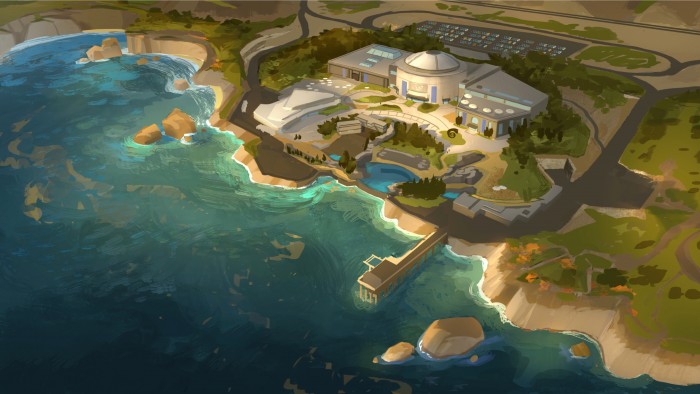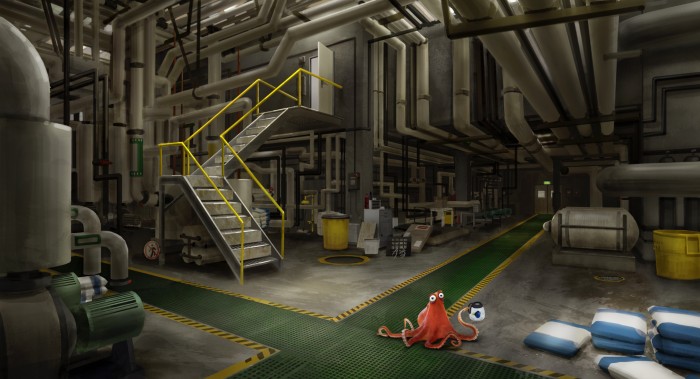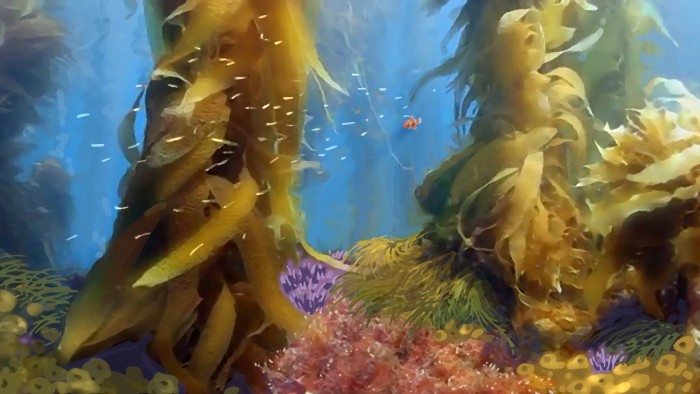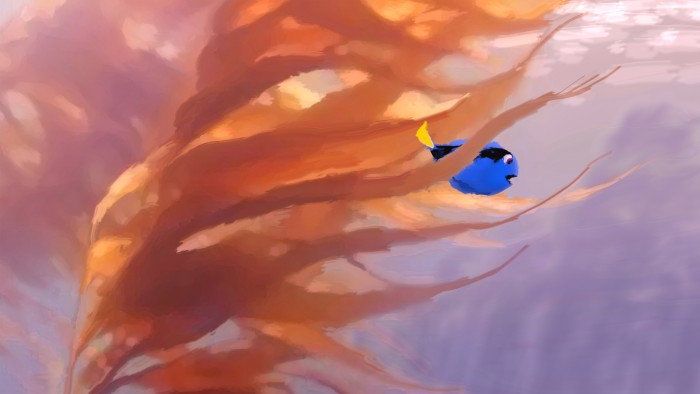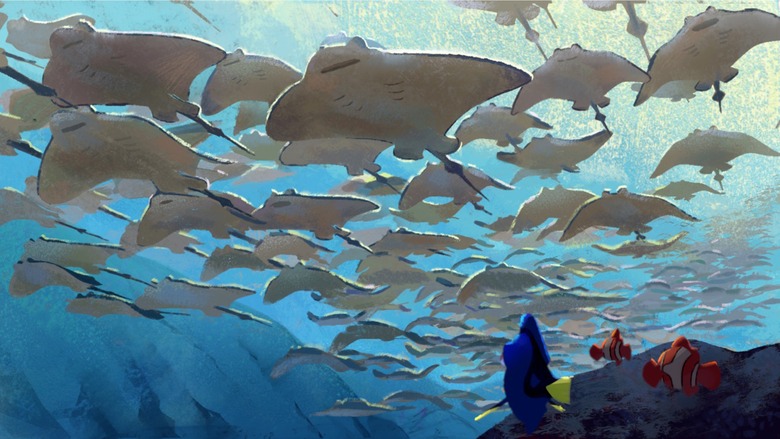Learn About The Real-Life Inspiration For 'Finding Dory'
Last month, I traveled to the Monterey Bay Aquarium to talk to Andrew Stanton and the filmmakers of Pixar's upcoming Finding Nemo sequel Finding Dory. On my visit, I got to preview 30 minutes of the upcoming film and chat with many of the filmmakers at Pixar who are creating Dory's next adventure. But not only that, I got to learn how Pixar took multiple research trips to the Monterey Bay Aquarium, which served as inspiration for the Marine Life Institute seen in the final film.
Note: the following report is compiled from roundtable interviews, presentations with Pixar creative leads and a one-on-one interview with director Andrew Stanton and producer Lindsey Collins.
Not Blackfish: The Evolution From Sea World to a Marine Research Rescue Facility
The adventure takes Dory to the California-based Marine Life Institute, a rescue and rehabilitation center and premiere aquarium. The MLI is vast, with an array of pools and educational exhibits. Some earlier reports said that before the movie Blackfish was released, the location was initially planned as a Sea World-style theme park. However, producer Lindsey Collins writes that off as the evolution of the idea.
When we first talked about it, it was all coming from a place like, where would a family be? How would she not have found them? Like how can we explain what she knows from the first film, like speaking whale and being able to read? So that kind of led us to being like, maybe she was in some sort of aquarium environment, because maybe that would lend itself to having those kind of... we loved the thought of, we laid clues kind of in the first film without knowing it. Now when you watch this film, you're like, wait a minute, now I understand why she knows how to read. Like, why else would she know how to read? And so that's kind of where it came from. And as kind of the idea I think [Andrew] had of having her be in, having been kind of from a facility, like an aquarium. And then it went all over the place. We went and found every research path. And then ultimately landed on some place like kind of the Monterey Bay Aquarium and then Marine Mammal Rescue. ... And then it kind of also allowed us to kind of delve into a little bit of, if all of these other characters she meets also have just something a little bit off with them that would require kind of care, like that there was something really nice about her kind of being surrounded by characters that are all dealing with their own issues. And that we were able to use those as mirrors as how she felt about herself. So it kind of evolved from there.
Stanton backs up his producer, saying that the research led them to a more research-style facility. I mentioned to Stanton that the Finding Nemo ride in EPCOT at Walt Disney World actually ends at an aquarium/marine research facility, almost as if it predicted this sequel. Stanton and his producer seemed shocked to realize this, as if it had never occurred to them before. Stanton admits, "That's so funny," while his producer Collins is willing to take credit after the fact, "There you go, it's like we meant it."
How the Monterey Bay Aquarium Influenced the Movie
While the Marine Life Institute seen in the film is a fictional aquarium/marine life sanctuary, it's largely inspired by Northern California's Monterey Bay Aquarium. Pixar also took research trips to other facilities like the aquarium in Vancouver, but Monterey was the one they visited first and most frequently.
On the trips to the aquarium, they captured tons of backstage photos in an effort to make the locations in the film look real. They found the human world is very desaturated and without color, and that the water tanks are full of color in the room. The location also influenced the rectangle and square design of this backstage human world.
While on their research trips to Monterey, they took a lot of photos from the point of view of the characters, so some of the photos are taken from the floor level, to mimic what the octopus' perspective might look like. They didn't recreate rooms from the Monterey Bay Aquarium itself but tried to recreate the feeling of the locations, mimicking the overall look and the color and incorporating little details.
Pixar also visited aquariums like the one in Monterey Bay to research the look of the underwater locations. Monterey Bay has it's own kelp forest, which contributed to the color and look of that location in the final film. The color of the kelp is very golden or yellow near the surface and not as green as you might expect. They took tons of video that helped them build the entire world of the movie.
They have to research every plant, how it changes from the surface to the ocean floor, how the colors change. Every rock on the ocean floor is painted, sculpted, and placed. They look to break repetition which sometimes comes up in CG.
They built an entire parking lot because there was a point where there were going to be scenes that took place in the lot, but in the final film it just appears in the background. Some of the outdoor pools are up against the water from the bay, giving a contrast between the real/natural world and the artificially created ones of the aquarium.
Some Ideas for Finding Dory Were First Created for Finding Nemo
A lot of the initial ideas for Finding Dory were born out of the creative development of Finding Nemo. Director Andrew Stanton explains how Pixar routinely returns to the lists of cut ideas from past projects when developing their sequels:
When I had started on Nemo, this is a little bit of a tangent, but I didn't know where to start. The ocean's a big, big place and there's so many places. I just started making a list, what are things I'd like to see? A jellyfish forest sounds fun. And submarine underwater wreck. And angler fish. And it just became this kind of, like, list of cool stuff, just like pure spectacle. And then as I went through the storyline of trying to figure out stuff, we kind of had this little limited toolbox to pull from. And it was sort of the same thing here. It wasn't that clean, but there's a lot of species and environments left on the table that we either tried or didn't get to try on the first movie that now you get to kind of expand upon and explore. It's where most of the other Toy Story sequels came from is, like, all this stuff that was just left on the cutting room floor. I mean, by the time we were done with Toy Story 2, between the two movies, we had done about five features worth of ideas. And that's a lot of fresh material. So you don't have to feel like you're sitting there trying to compare yourself to the first movie. You're just going oh, can I start working with this fertile stuff that came from just the desire to be in this world? And it's the same thing with Nemo.
Their deep dive into the Finding Nemo archives resulted in rediscovering an abandoned location they pulled out of the dusty boxes for Finding Dory. One of the exhibits unique to the Monterey Bay Aquarium is the kelp forest, something Stanton wanted to bring to Finding Nemo but found himself unable to.
We wanted to go to the kelp forest of underwater so badly 'cause it's so unique. And I couldn't ever justify it in the first movie, 'cause it just is so specific to this coastline. And so it was one of those nice things where we could make this story take place anywhere at the beginning. So we kind of planted a pin here just to see if it would hold and it held.
The Bold Contrast in the Film's Four Environments
Art director Don Shank explained to me that since the scope of a movie like this is so big, featuring lots of environments in both fish and human scale, they purposely created bold contrasts to separate the four different environments in the story. The fish environments like the reef are very circular, giving a friendly feel. The kelp forest is created using rhythmic shapes, giving a more alien feel to that fish environment. They often defined the underwater areas with large empty space. And the human world was presented in a very blocky/rectilinear motif, making it unfriendly to a fish.
An Abandoned Sequence
Pixar spent a lot of time designing the Marine Life Institute, and yet one of the areas of the aquarium did not make it into the film film. One of the things abandoned in development were a series of sequences which involved Marlin and Nemo trying to find Dory.
For Dory to learn to drive on her own basically they had to be separated. So we were like, well, what do we do with them and where do they go? And we had a, I don't wanna give anything away yet, but we had a long, I hope it all comes out on the DVD, 'cause it was really fun. We had a long circuitous route, that's all I'm gonna say, with them that ended up not helping her story at all. And I had to finally just say you're right. And we got so much better stuff that worked and made the movie much better. But as a side idea, it was fantastic. And hopefully it will show up on the DVD.
Stanton said the sequences were in the film for "a long time," admitting that they were "seductive, just put it that way." We'll have to wait until the DVD to find out what he's talking about.

